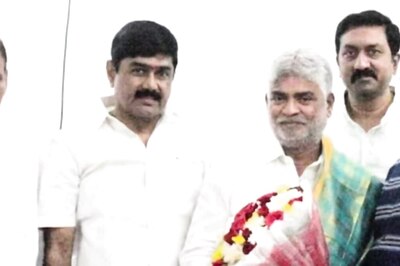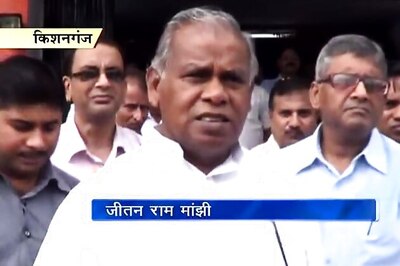
views
Before the 2019 Lok Sabha elections, most pre-poll surveys predicted a tough fight between Congress’s incumbent MP Rahul Gandhi and Bharatiya Janata Party’s Smriti Irani for the Amethi Lok Sabha seat. The election result only confirmed this. Rahul lost to Smriti by around 6% of votes.
Raebareli and Amethi were two Lok Sabha constituencies in Uttar Pradesh seen as the Gandhi family’s bastions for years. 2019 added the Amethi chapter to the Congress’s political downfall in the state. Will Raebareli add another chapter this year, with its larger pan-India reflection, as seen with Amethi’s loss in 2019?
Sonia Gandhi, who was the MP from Raebareli till recently, decided not to contest the election this time. She is now a Rajya Sabha member. The seat has been represented in the past by Feroze Gandhi and Indira Gandhi as well. Priyanka Gandhi Vadra’s name is doing the rounds for this year’s election to replace Sonia Gandhi, though the Congress is yet to finalise a candidate for this seat. Polls for Amethi and Raebareli are scheduled to take place on May 20, in the fifth round of the ongoing seven-phase elections.
If we look at the electoral trends in Amethi over the years in its Lok Sabha and assembly polls, we see figures that will not offer comfort to Rahul Gandhi and the Congress. The 2019 result only reflected this. Senior BJP leader Smriti Irani was Rahul’s rival in the 2014 Lok Sabha polls. That year, Rahul’s winning margin was significantly reduced. BJP chose to make Amethi a base for Smriti following that 2014 election. She remained there as an active political worker and won the next election, marking the biggest electoral setback of the 2019 Lok Sabha polls.
The win was driven by many factors, like anti-incumbency for the Congress-led United Progressive Alliance since 2014, the Narendra Modi wave in 2014 and 2019, the return of stable non-Congress governments in the state, BJP’s emergence as Uttar Pradesh’s ruling government in 2017 following its stunning victory in the assembly polls, and the Congress’s ground-level political disconnect in the Amethi parliamentary constituency (PC), as shown by the previous electoral outcomes here.
The Amethi parliamentary constituency, created in 1967, was a Congress bastion before the 2019 Lok Sabha election. Till then, it was ruled by non-Congress parties only twice, and that too only for four years. First, it was post-Emergency in 1977, when a Janata Party candidate won and remained its representative in Lok Sabha till 1980. Then party-hopper and Amethi prince Sanjay Sinh won on a BJP ticket in 1998. But being a prince was no guarantee for ground connect in Amethi with its Nehru-Gandhi rapport.
Sanjay Sinh became Lok Sabha MP from Amethi when the Congress was going through a tough phase with no Gandhi leader at the top. Sonia Gandhi, who had earlier refused to enter politics, had only recently joined the party, and Sanjay Sinh had a chance.
But when Sonia decided to contest from Amethi in 1999, history was going to repeat itself, as it had done in the past. Sinh, who had earlier seen a massive defeat against Rajiv Gandhi in 1989, faced a huge electoral loss from a Gandhi once again. Sonia Gandhi won by over 300,000 votes, with a victory margin of 48%.
When Rahul decided to join politics, Amethi was chosen as his constituency and Sonia Gandhi shifted to Raebareli. Rahul won his first Lok Sabha election from Amethi handsomely, with a winning margin of 49%, and went on to amplify his victory margin in 2009 to 57%.
It was around this time that electoral politics saw a significant change in the state, following years of unstable governments and coalition politics. The electorate of the state decided to opt for and elect stable governments, giving them the complete majority they needed. Bahujan Samaj Party’s Mayawati was chief minister from 2007 to 2012, and Samajwadi Party’s Akhilesh Yadav from 2012 to 2017. Following that, Yogi Adityanath from the BJP became the CM. His first term was from 2017 to 2022, and he is in the middle of his second.
First the SP and BSP, then the BJP, SP, and BSP. UP’s politics started revolving around these three parties. The Congress, already on a political downfall in the state, was further reduced to the electoral margins, and Amethi was no exception. The party that had once ruled the state for decades, was reduced to a few seats and an abysmal vote share for political survival.
The Amethi parliamentary constituency has five assembly seats – Tiloi, Salon, Jagadishpur, Gauriganj, and Amethi. On average, the Congress won 34% of votes in the 2007 Uttar Pradesh assembly elections in these five seats. The party’s votes were gradually reduced to 30% in the 2012 assembly elections, 25% in 2017, and just 14% in 2022.

In 2007, the Congress won three assembly seats falling under the Lok Sabha constituency while it was in second place in the other two. In 2012, it was two wins followed by three runner-up positions. The party could not win any seats in 2017 and 2022. In 2017, it was the first runner-up in three assembly segments, the second runner-up in one, and the third runner-up in another. In 2022, the first runner-up position was reduced to just one assembly seat while it was the second runner-up in another four.
Can assembly election results impact the outcome of the corresponding Lok Sabha seat or vice versa? It is debatable, with electoral outcome analysis saying sometimes it matters and sometimes it doesn’t. But in the case of Amethi, the Congress’s slide on the performance marker has been a trend election after election for a long time.
The party was gradually losing its assembly seats and votes and when a strong candidate like Smriti Irani was fielded again against Rahul Gandhi in 2019 after giving a tough fight in 2014, there was a clear possibility that the Amethi result could turn out in any way. Also, it coincided with the Congress getting historically low numbers, 44 seats in the 2014 Lok Sabha elections and 52 in 2019, with many assembly election losses in between, showing the party’s and cadres’ poor morale. While the 2014 contest between Rahul and Smriti saw the Congress leader’s winning margin reduced to 12% from 57% five years ago, the 2019 outcome was the grand old party’s biggest setback since Indira Gandhi’s electoral loss in 1977.

Rahul coming back to Amethi for the 2024 Lok Sabha elections is always a possibility, but these factors will always be in the minds of the party’s strategists despite the SP-Congress coalition under the INDIA bloc this time. Add to it other electoral concerns.
SP’s Akhilesh Yadav is leading his first electoral battle following the demise of his father and one of the political stalwarts of Uttar Pradesh, Mulayam Singh Yadav. The SP and Congress fought the 2017 assembly elections together, but it turned out to be a bad political experiment. Their cadres were not united, and both parties failed to appeal to each other’s traditional vote banks. Besides, there is the impact of the January Ram temple consecration in Ayodhya, one of the most significant election issues in Uttar Pradesh and in many other states. The Congress decided not to attend the ceremony, a decision that received criticism from various quarters.
Stay Ahead With all the Lok Sabha Election 2024 Related Real-Time Updates At News18 Website.


















Comments
0 comment